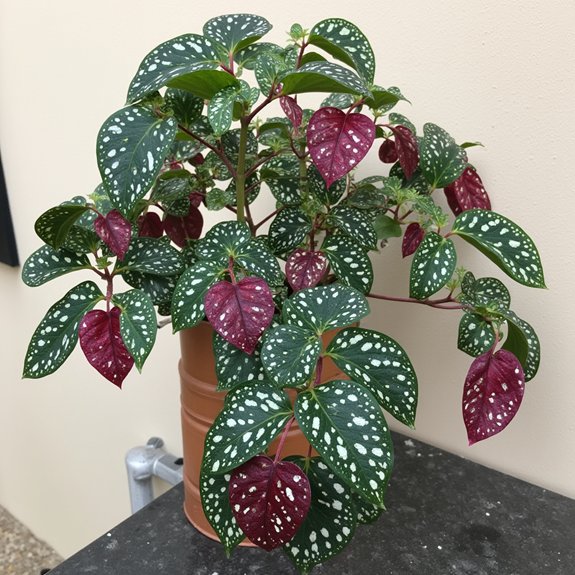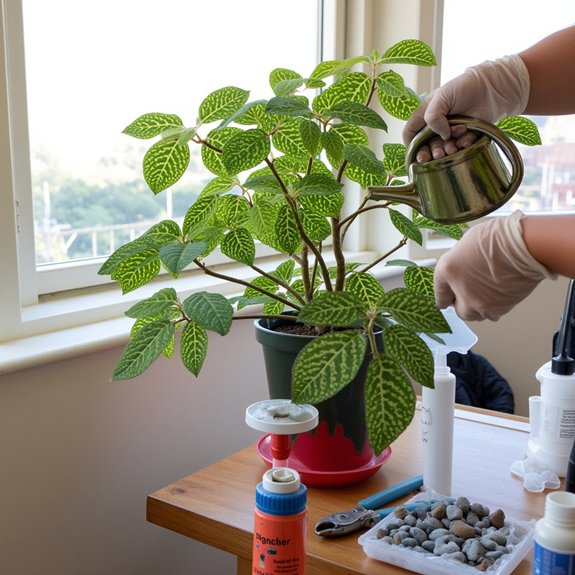Like Cleopatra commanding attention with her striking beauty, the Begonia maculata demands respect through its dramatic polka-dotted leaves and crimson undersides. You’ll discover that this Brazilian native isn’t your typical houseplant – it’s a temperamental artist requiring precise conditions to flourish. Master the delicate balance of light, humidity, and watering, and you’ll reveal the secrets to keeping those iconic silver spots vibrant while preventing the dreaded leaf drop that haunts most beginners.
Contents
- 1 Understanding the Polka Dot Begonia’s Origins and Characteristics
- 2 Creating the Perfect Growing Environment
- 3 Essential Watering and Soil Requirements
- 4 Temperature, Humidity, and Light Management
- 5 Feeding and Seasonal Care Practices
- 6 Propagation Techniques and Repotting Guidelines
- 7 Troubleshooting Common Issues and Pest Prevention
Understanding the Polka Dot Begonia’s Origins and Characteristics

The Polka Dot Begonia, scientifically known as Begonia maculata, has been capturing plant enthusiasts’ hearts since the late 1600s when French botanist Charles Plumier first documented this striking specimen. Named after Michel Begon, Haiti’s governor, this plant carries significant historical significance beyond its Instagram fame. Originally discovered in Brazil, it’s spread across Central America, Asia, and South Africa.
You’ll recognize its distinctive arrow-shaped leaves with white polka dots and deep red undersides that resemble designer shoe soles. Historically, people valued it for medicinal uses, though today it is understood to be toxic if ingested by pets or humans.
Creating the Perfect Growing Environment
Since your Polka Dot Begonia’s stunning appearance depends entirely on proper environmental conditions, you’ll need to master four key elements: light, water, soil, and humidity. Position your plant near east or west-facing windows where light angles provide bright, indirect sunlight without scorching those gorgeous spotted leaves.
Create your ideal soil mix using two parts potting soil, one part perlite, and one part peat moss. This combination guarantees proper drainage while retaining moisture. Among soil types, this airy blend prevents root rot better than standard potting mixes.
Maintain 65-80°F temperatures with humidity levels reaching 75% for best growth.
Essential Watering and Soil Requirements

When watering your Polka Dot Begonia, you’ll prevent most problems by checking soil moisture before each session. Stick your finger into the top inch—if it’s dry, it’s time to water deeply and slowly.
Your watering frequency depends on environmental factors, but typically ranges from once weekly to every ten days. Overwatering causes root rot, while underwatering leads to wilting and yellowing leaves.
Soil types matter greatly for drainage and health. Mix two parts potting soil with one part perlite and one part peat moss or coconut coir. This creates the light, airy foundation your begonia craves.
Temperature, Humidity, and Light Management
Although Begonia Maculata appears delicate, it’s surprisingly adaptable when you maintain proper environmental conditions. Position your plant near east or west-facing windows for ideal light intensity, avoiding harsh direct sunlight that’ll scorch those gorgeous spotted leaves. Temperature-wise, keep it cozy between 65°F and 80°F—basically room temperature works perfectly.
Here’s where things get tricky: humidity levels. Your Begonia craves 75% humidity, which most homes can’t provide naturally. Place a humidifier nearby, group plants together, or use pebble trays with water. Skip the misting though—those thick leaves don’t appreciate getting soggy, and you’ll invite unwanted fungal problems.
Feeding and Seasonal Care Practices

Beyond creating the perfect environment, your Begonia Maculata needs regular feeding to maintain those stunning spotted leaves and robust growth. During spring and summer, use diluted liquid fertilizers every two weeks. Mix your chosen fertilizer to half-strength, as full concentration can burn delicate roots.
Winter changes everything. Your plant enters dormancy, so reduce feeding to once monthly or stop completely. Different fertilizer types work well: balanced 10-10-10 formulas or fish emulsion both deliver excellent results.
These seasonal adjustments prevent nutrient buildup during slower growth periods while ensuring adequate nutrition when your begonia’s actively producing new spotted foliage.
Propagation Techniques and Repotting Guidelines
As your Begonia Maculata matures, you’ll want to multiply your collection through stem cuttings, the most reliable propagation method for this spotted beauty. Clean your gardening tools first, then select healthy stems with several nodes. Cut just below a node, creating 4-6 inch sections.
Place cuttings in water or moist potting mix. Root development takes 5-7 weeks, so patience pays off. You’ll see tiny white roots emerging from the nodes.
For repotting, choose spring when growth accelerates. Select a pot one size larger, shake off old soil gently, then water immediately after transplanting.
Troubleshooting Common Issues and Pest Prevention
Even when you’re providing excellent care, your Begonia Maculata can develop problems that’ll frustrate any plant parent. Leaf discoloration often signals watering issues—yellowing indicates overwatering, while browning edges suggest underwatering or low humidity. Monitor humidity levels and adjust accordingly.
For pest identification, check leaf undersides regularly for mealybugs and whiteflies. These tiny invaders appear as white, cotton-like clusters or small flying insects. Apply neem oil immediately when you spot them, repeating treatments weekly until eliminated.
Early detection prevents major infestations, so inspect your plant during regular maintenance. Consistent monitoring keeps problems manageable.
